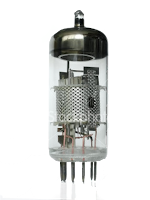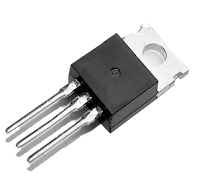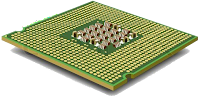In computer Technology, the word generation is descried as a stage of technological development or innovations, a major technological development that fundamentally changed the way of computers. Operate resulting in -------------- smaller, cheaper, more powerful and more effective and reliable devices. Characteristic in each generations growth of the computer industry.
There are five totally computers generations known until today.
- 1st Generation Computers (1942-1955)
- 2nd Generation Computers (1956-1964)
- 3rd Generation Computers (1965-1974)
- 4th Generation Computers (1975-1990)
- 5th Generation Computers (1990-Till Present)
1st Generation Computers (1942-1955):
 |
| Vacuum Tubes |
This Computers Occupied the Large room. Inputs is this Computers where given by Punch cards. This Computers had a Very Slow Speed. This Computers Where very Expensive Computers. They Can Perform Computation in Millie- Seconds. This Computer work on the Principals of Storing Programs. Instructions. ENICA, EDVAC, EDSAC, UNIVAC-I and IBM-701 Where the 1st Generation Computers.
John Bardeen, William Shakley and Walter Houser Brattain Invented a New Transistor (A New Electronic Switching Device). at Bell Labourty USA is 1947 and there for it come to be know as "Transistor Age" 2nd Generation due to the use of Transistors having following Properties.
Characteristics of 1st Generation:
- They Where the Fastest Calculating Device of that time.
- They Where Bulky and Required Large Room.
- They Used thousand of "Vacuums Tubes" that limited Heat and Where Frequently Burned out.
- The Power Consumption of these computer was high.
- They where Prone the Frequent hardware failure because the used those of vacuums Tubes.
- They Required Consist maintain Due to low mean time between Failure.
- Commercial Production of this computer Where Difficult and Costly (As Thousand of Individual Component had to be Assembled manually by hand into functioning Unit).
- They Had limited commercial Use (As the computer where difficult to program and used. Instruction Where Written in machine and assembly Language.
2nd Generation Computers (1956-1965):
John Bardeen, William Shakley and Walter Houser Brattain Invented a New Transistor (A New Electronic Switching Device). at Bell Labourty USA is 1947 and there for it come to be know as "Transistor Age" 2nd Generation due to the use of Transistors having following Properties.
 |
| Transistor |
- They where Easier to handle.
- They where made of Germanium Semi-Conductor Martial Either like Glass.
- They put Switch much Faster (Almost Ten Time faster then Tubes).
- They Consume 1/10 the power of consumed by Tubes.
- They Where smaller then Tubes.
- They where Less Expensive to Produce.
- They Dissipated Less Then Heats as compared to Tubes.
This Generation Saw the Emergence of the High Level Language (HLL) Such as FORTRAN, COBOL, ALGOL and Snowball this Generation also Introduce Batch Processing Operating Systems.
Characteristics of 2nd Generation:
- This Computer Where ten time faster then 1st Generation Computers.
- They Where Smaller and Required Less Space.
- They Consume less power and Dissipated less heats still Required Proper Air Condition.
- They Where Less Prone to Hardware Failure.
- They had large Primary and Secondary Memory/ Storage.
- They Where Easier to Program.
- They had Wider Commercial Used.
- Commercial Production was still Difficult, Costly and as thousand of transistor had to be assembled manually by hand into functioning Units.
3rd Generation Computers (1966-1974):
3rd Generation Computer Used Integrated Circuits (IC), Where Developed in this Generation by "Jack St. Clair Kilby" and "Robert Noyce" in 1985, Integrated Circuits (I.C) are Circuits Consisting of Several Electronic Components likes, Transistors, Restores and Capacitor grown as on a single Chip of Silicon aliments wired interconnects between components. IC (Integrated Circuits) Technology was also known as "Micro Electronics" Technology as it made it possible to integrate large numbers of circuits components into Very small (Less this 5 mm2) Surface of silicon known as "Chip".
.png) |
| Integrated Circuits |
Essentially Integrated Circuits Content only about 10-20 Components on the Silicon Chip. This is Called Small Scale Integration (SSI) Technology. Later about 100 Components Where Imbetted on the Silicon Chip. This was Called Medium Scale Integration (MSI) Technology. Integrated Circuits Where Also Known as "Micro Electronics" Because its made it possible to integrate numbers of Circuits Components into Very Small Chip.
Hence, Integrated Circuits (IC) is Smaller, Less Expensive, Faster in Operation, Dissipated less Heats and Consume less Power there for 3rd Generation Computer Where More Powerful Reliable, less Expensive and Cooler to Operate. 3rd Generation Computer had typically Few MB (Mega Bytes) of Main Memory. Made up of magnetic Course. Based of RAM (Random Access Memory) and magnetic Disk Capable of storing Few Tens of Mega Bytes (MB) of data Per Disk Device. Which is Larger then before. 3rd Generation Also Interface "Mini Computer"
The 1st Commercial Available Mini Computer in 1965 was PDP-8 (Programmed Data Processing) by DEC (Digital Equipment Corporation). 3rd Generation also Saw the Emergence of Time Sharing Operating System and Creation of an Independent software Industries also happen in this Generations.
Characteristics of 3rd Generations
- 3rd Generation Computer where more Powerful and Capable of Performing about 1 Million Instructions Per Seconds.
- The Computer Where Smaller then 2nd Generation computers and Required Small Space
- This Computers Consume Less Power and Dissipated Less Heats.
- They had Faster and Larger Primary and Secondary Storage or Memory.
- This Computer Where Suitable for Scientific and Commercial Application.
- Commercial Production of this System was Easier and Cheaper.
- Time Sharing Operating System (OS) Allowed Interactive Usage by Multiple Users.
4th Generation Computers (1975-1984):
4th Generation Computers is an Extension of 3rd Generation Technology yet it was still based on IC (Integrated Circuits) that is Micro Processor.
 |
| Micro Processor |
Hence, This Age was known as "Micro Processor Age". A M/P is Built on to a single Piece of Silicon which known as chips. Which is about 0.50 cm along on side & not more than 0.05 cm thick. A Micro Processor Contained all Circuits Needed to Perform Arithmetic Logical & Control Function. Thus, Computers Become Incredibly Compact & its Become Possible For many to Own a computer

0 comments:
Post a Comment